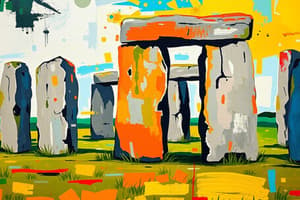Podcast
Questions and Answers
What is one potential purpose of stone alignments in Irish field monuments?
What is one potential purpose of stone alignments in Irish field monuments?
- For astronomical observations (correct)
- To signify agricultural boundaries
- As shelter for livestock
- To mark trade routes
Which type of monument is characterized by circular arrangements of standing stones?
Which type of monument is characterized by circular arrangements of standing stones?
- Stone circles (correct)
- Cairns
- Round barrows
- Passage graves
What does the presence of tombs indicate about prehistoric societies in Ireland?
What does the presence of tombs indicate about prehistoric societies in Ireland?
- Preference for communal living
- Importance of burial practices (correct)
- Lack of belief in an afterlife
- Minimal social structure
What role did some field monuments serve related to land ownership?
What role did some field monuments serve related to land ownership?
During which period were many Irish field monuments constructed?
During which period were many Irish field monuments constructed?
How do field monuments contribute to our understanding of early Irish societies?
How do field monuments contribute to our understanding of early Irish societies?
Which type of monument is often associated with burial practices and can include mounds made of earth?
Which type of monument is often associated with burial practices and can include mounds made of earth?
What is a significant reason for the conservation of Irish field monuments?
What is a significant reason for the conservation of Irish field monuments?
What is the significance of ongoing research related to ancient structures in Ireland?
What is the significance of ongoing research related to ancient structures in Ireland?
What does regional variation in field monuments in Ireland indicate?
What does regional variation in field monuments in Ireland indicate?
What is one of the main challenges in interpreting ancient monuments in Ireland?
What is one of the main challenges in interpreting ancient monuments in Ireland?
Why is comparative analysis across different regions important in studying Irish field monuments?
Why is comparative analysis across different regions important in studying Irish field monuments?
What method is often relied upon to understand the precise purpose of ancient monuments?
What method is often relied upon to understand the precise purpose of ancient monuments?
Flashcards
Archaeology
Archaeology
The study of ancient structures and artifacts to understand past societies and cultures.
Regional Variation in Irish Field Monuments
Regional Variation in Irish Field Monuments
Differences in the types and distribution of ancient structures across different regions of Ireland, reflecting variations in early settlement and cultural practices.
Irish Field Monuments
Irish Field Monuments
Ancient structures in Ireland that were built for various purposes like ceremonial gatherings, burial sites, or agricultural boundaries.
Challenges in Interpreting Ancient Structures
Challenges in Interpreting Ancient Structures
Signup and view all the flashcards
Comparative Analysis of Field Monuments
Comparative Analysis of Field Monuments
Signup and view all the flashcards
Stone alignments
Stone alignments
Signup and view all the flashcards
Stone circles
Stone circles
Signup and view all the flashcards
Cairns
Cairns
Signup and view all the flashcards
Tombs
Tombs
Signup and view all the flashcards
Round barrows
Round barrows
Signup and view all the flashcards
Functions of Field Monuments
Functions of Field Monuments
Signup and view all the flashcards
Significance of Field Monuments
Significance of Field Monuments
Signup and view all the flashcards
Conservation of Field Monuments
Conservation of Field Monuments
Signup and view all the flashcards
Study Notes
Introduction
- Irish field monuments are diverse prehistoric structures across the island.
- They represent key aspects of early Irish culture and society.
- Monuments vary in size, scale, and design, revealing past human activity.
- Understanding these sites is vital for appreciating Irish history and prehistory.
Types of Field Monuments
- Stone alignments: Linear arrangements of standing stones, potentially used for astronomical observation, ritual, or boundary marking.
- Stone circles: Circular arrangements of standing stones, often found with other monuments, suggesting ceremonial or burial functions.
- Cairns: Earth and stone mounds, used as burial sites or for ceremonial purposes, exhibiting diverse construction techniques and sizes.
- Tombs: Structures like passage graves, chambered tombs, and wedge tombs, containing human remains, highlighting burial practices' importance.
- Round barrows: Earth mounds often with burials, reflecting the social and ritual needs of the communities.
Functions of Field Monuments
- Many monuments likely served multiple purposes, including ceremonial rituals, communal activities, boundary marking, and commemorating important figures/events.
- Some were primarily burial sites, reflecting beliefs about death, the afterlife, and ancestor veneration.
- Others might have been primarily ritualistic, with astronomical alignments and orientations as potential examples.
- Some field monuments defined land ownership and community boundaries.
Dating and Significance
- Many Irish field monuments date to the Neolithic, Bronze, and early Iron Ages.
- Radiocarbon dating and other archaeological techniques are used to determine monument ages.
- Monuments offer valuable insights into past societies' social dynamics, beliefs, and cultural practices.
- Studying these monuments helps understand early societies' interactions with their environment.
Conservation and Research
- Maintaining and preserving these vulnerable monuments is crucial for future generations.
- Ongoing research is essential to interpret the meanings behind these ancient structures and understand early Irish cultural development.
- Archaeological investigations provide insights into the sites' significance and functions.
Regional Variation
- Regional variations in field monument types and distributions illustrate regional diversity in early settlements and cultural practices.
- Some areas have high concentrations of particular monument types, potentially reflecting local traditions and resources.
- Comparative analysis across regions highlights interconnectedness and cultural exchange.
Challenges to Interpretation
- Interpreting these monuments is challenging due to the passage of time and lack of written records from the period.
- Understanding precise purpose and symbolism relies on analyzing associated artifacts and environmental contexts.
- The complexity of archaeological evidence and past human behaviour makes precise interpretations challenging.
Studying That Suits You
Use AI to generate personalized quizzes and flashcards to suit your learning preferences.




